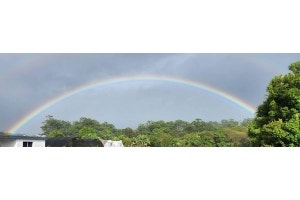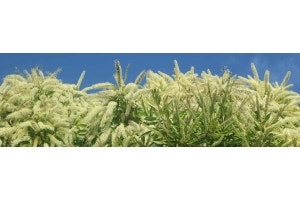
How good are lawns?
- They provide a restful outlook from our lounge room window.
- They cool the soil beneath, and lower air temperatures.
- They soak up valuable fresh rainwater and return it to the earth (unlike hard surfaces which rain runs straight off, into the storm drains, and out to sea.)
- They provide shelter for tiny yet essential creatures which help maintain our gardens.
- They feel soft between our toes.
Which Lawn Alternative is best for your garden?
There’s heaps of lovely lawn alternatives that will give you a lush green carpet in your backyard, need much less looking after, and - for gentle walking, sitting, relaxing, and snoozing on – will look good all year round.
Here's some of our favourites, click the names to jump to their page and read more : Zoysia - no mow grass, Korean velvet grass
Zoysia - no mow grass, Korean velvet grassThe clue’s in the name here with this plant! Zoysia is a bright apple green, short and dense, and very soft to touch. Planted en masse it creates ripples and undulations like a river, as you can see in the image.
Sagina – moss
Irish moss is shorter, denser, and deeper green; Scotch moss is taller, more open, and lime green. They are both cushiony, soft to touch (in fact, almost irresistible in their squooshiness), and very low growing. Sagina is perfect nestled between pavers, or as a lawn for low-traffic areas.
 Festuca glauca – blue fescue
Festuca glauca – blue fescueFrost tolerant, drought tolerant, easy care, lovely steely blue-green colour – it’s no wonder this fescue grass is so popular. There’s an ice-blue version too, Elijah Blue. Both have fine leaves, soft to touch, and a compact tufty shape.
Ophiopogon – mondo grass
There’s quite a few versions of this popular Japanese grassy plant. It comes in classic ankle high, dwarf barely-covering-your-toes high, white stripe, and even jet black flavours to suit all kinds of garden style. Mondo grass is often planted around paving in public parks, so it can definitely stand up to home use! You can see it here at Roma Park in Brisbane.
 Lomandra – mat rush
Lomandra – mat rushLomandra native species like hystrix and longifolia are big bold grassy plants, ideal for feature planting and revegetating wild areas. Over the years, plant breeders have developed small, fine-leaved dwarf varieties that suit our gardens much better, and are just as resilient as their big siblings. Several, like Lime Tuff, Evergreen Baby, and Echidna Grass, will reach calf-high when mature; while Little Con - pictured - will only tickle your ankles.
If you have a lawn you don’t walk on, and don’t want to mow any more, these dwarf lomandras are ideal. A once-yearly haircut is all they need.
 Dymondia – silver carpet
Dymondia – silver carpetIt’s not very grassy looking, with those white-reverse leaves and golden daisy flowers - but we can't go past it because it’s such a great lawn alternative for Aussie gardens. Dymondia grows in poor dry soils and hot sunny spots, and once it’s established is very drought tolerant. It knits together into a dense mesh, perfect for bank binding and weed suppressing too.

































